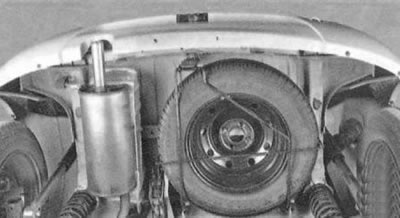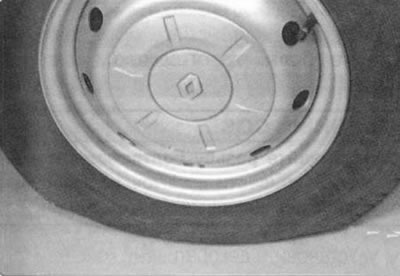
A flat tire is a nuisance that every driver faces sooner or later. Air from a flat tire can escape quickly or slowly, depending on the size of the object that punctured the tire and what tires are installed on the car: tube or tubeless. With a small nail in a tubeless tire, you can drive for many days before you notice that the wheel «deflated».
It is very important to determine in time that a tire has been punctured. While driving, pay attention to the behavior of the car: if it has become difficult to accelerate, the effort on the steering wheel has increased when maneuvering, or the directional stability has worsened, be sure to check the tire pressure.
The easiest way to repair a wheel is to go to the nearest tire shop, where the repair will be done quickly, professionally and, as a rule, at a very affordable price.
Warning: Do not try to get to a tire shop on a completely flat tire: Just drive a few dozen meters like that and the tire will have to be thrown away.
The damaged wheel needs to be replaced with the spare one. This is a fairly simple operation, but it does require some skill.
If you have a flat tire, turn on the hazard warning lights, brake smoothly to 2-3 km/h, try to carefully move to the edge of the roadway in first gear and stop as far to the right as possible at the shoulder, and if possible, outside the roadway. If road conditions permit and it does not contradict the requirements of the Traffic Regulations, then if any tire on the right side of the car is flat, pull over to the right shoulder, if on the left - to the left. Try not to stop the car in places where the road is poorly visible: on sharp turns, on descents and ascents, bridges, in tunnels. If the car remains on the roadway, first of all ensure your own safety and the safety of other road users! Turn on the hazard warning lights and install an emergency stop sign.
Warning: Remember that changing a tire in the middle of a multi-lane highway puts your life and the lives of other road users at risk. Therefore, in some cases, it is wiser to move the car to the side of the road or a parking lot to change a tire, even if this completely ruins the damaged tire. Life and health are more important than the material costs of buying a new tire.
Wheel replacement
Warning: If you return to your parked car and find a flat tire, be careful. It may have been punctured by thieves in order to steal valuables from the car while you are busy changing the tire and concentrating on your work.
1. Engage 1st gear in a manual transmission or move the selector lever of an automatic transmission to the position «R» (parking), apply the parking brake. Ask the passengers to exit the vehicle. If you were towing a trailer, disconnect it from the vehicle. Remove the key from the ignition to prevent the engine from starting accidentally. Open the tailgate (it contains everything you need to change a wheel).
Note.
- The jack is secured to the left side of the luggage compartment...
- ...and the wheel brace is on the right.
- The spare wheel is located under the body floor at the rear of the vehicle.

2. To remove the spare wheel, bend back the cut-out part of the boot floor...
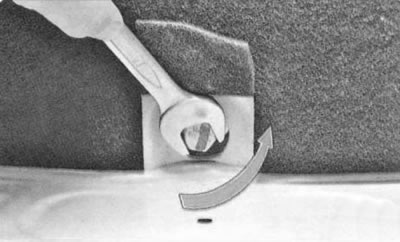
3....unscrew the spare wheel holder bolt several turns counterclockwise (It is not necessary to unscrew the bolt completely).
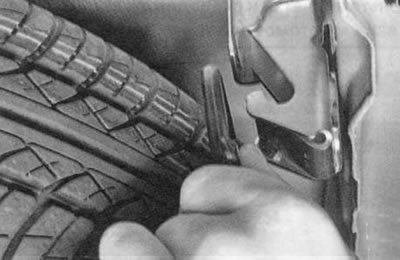
4. Disconnect the spare tire holder from the bracket.

5. Remove the spare tire from the holder and place it under the body sill next to the tire being replaced.
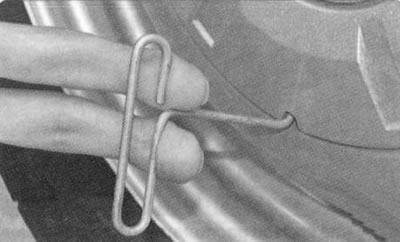
6. Use the hook attached to the car to pry up the edge of the decorative cap...
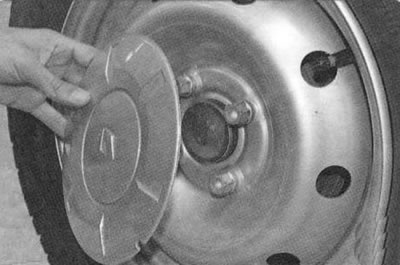
7....and remove the cap.

8. Place a jack under the vehicle next to the wheel to be replaced (see «Using a jack»).
Helpful Hint: To avoid getting dirty when changing a tire, wear gloves and protective clothing if your vehicle has them.
9. The car on the opposite side must be secured by placing wheel chocks under the front and rear wheels so that the raised car cannot move forward or backward.

10. Raise the vehicle slightly with a jack so that the wheel to be replaced is not lifted off the road. Loosen the four wheel mounting bolts with a wheel brace.
Helpful advice: To make it easier to unscrew the bolts, we recommend purchasing a special wheel wrench with a telescopic handle.

11. Jack up the car until the wheel is clear of the road, then completely remove the bolts and remove the wheel.
Warnings:
- Try to keep the car suspended with the wheel removed for as little time as possible.
- Raise the vehicle with a jack only to the height necessary to remove and install the wheel.
- If you are working on soft ground, place a thick board under the base of the jack. Do not use bricks for this purpose - they easily split and the car may fall off the jack, seriously injuring you.

12. Install the spare wheel in place of the removed one, screw in the mounting bolts until they stop, but do not tighten them.
Warning: Before installing the spare wheel, thoroughly clean the mating surfaces of the wheel disc and hub from dirt using a wiping cloth or brush. Be careful: these parts may have heated up to a high temperature during driving. When screwing in the bolts, make sure that their conical parts are aligned with the conical surfaces of the holes in the wheel disc, otherwise the bolts will loosen during driving and the wheel will be lost.
13. Lower the vehicle and finally tighten the bolts crosswise to 105 Nm.
Helpful advice: Do not lubricate the threads of the mounting bolts - this may lead to the bolts loosening while the car is moving.
14. Install the decorative cap.
15. Before continuing driving, be sure to check the air pressure in your tires.
Helpful Hint: The car has tubeless tires. If you don't have the skills to install tires, we advise you not to try to do this job yourself. One sidewall damage and you'll have to buy a new tire or install a tube.
In a desperate situation, you can use a special first aid kit for repairing tubeless tires without dismounting, or tire sealant. They must be used in accordance with the attached instructions. How is tubeless better than tubed? Tubeless when punctured «descends» very slowly: you can pump it up and drive for weeks with a nail in the wheel until you have the opportunity to repair it.



